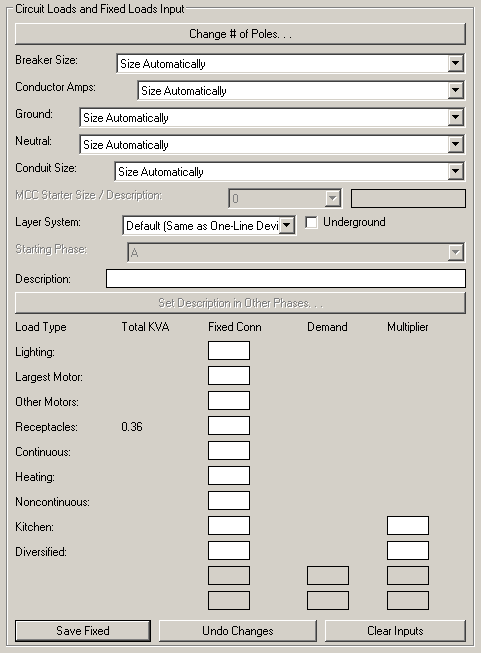Circuits in Design Master Electrical have a number of default settings that work for most situations. These defaults can be overridden when your design calls for something else. To change these settings, open the Circuiting dialog, select the circuit that needs to be different, and make the changes in the “Circuit Loads and Fixed Loads Input” section on the right.

Breaker Size: Breakers are automatically sized based upon 125% of the continuous and 100% of the noncontinuous load. If you need a larger or smaller breaker, you can change that here. Changing the breaker size will change the branch circuit wire sizes as well.
Conductor Amps: The conductor amps are sized to match the breaker size. In situations where you need larger conductors but not a larger breaker, such as when you need to account for a large voltage drop, you can make that change here.
Ground: Ground wires are included by default on all circuits. You can remove the ground wire here, or you can choose a different size.
Neutral: A neutral is included on circuits that are connected to devices that have a neutral. Circuits that do not include a neutral by default can have one added here. The neutral size can also be changed. Otherwise, it is sized to match the conductors.
Layer System: The layer system controls the layer that is used when inserting the loops for the circuit. The default can be set in the options to either be a specific layer system, or to match the layer system of the panel. Individual circuits can always be set to a specific layer system here.
Underground: By default, this box is not checked. When it is checked, the circuit is marked as being underground and uses a different layer for the loops, typically one that is dashed.
Starting Phase: For panels, the starting phase for the circuits is fixed. For other types of one-line devices, the starting phase defaults to A, but can be changed. When you have multiple single-pole loads on a three-pole switchboard, it is important to change the starting phase of some of the loads to keep the switchboard balanced.
Description: The description for a circuit is taken from the devices that are connected to it. You can use this field to add additional information to the description. See this support blog post for more details about all of the locations where the circuit description can be set in our software: Changing Circuit Descriptions.
Set Description in Other Phases: If the circuit has 2 or 3 poles, the description is associated with the first pole. This button is used to set the description on the other poles.
